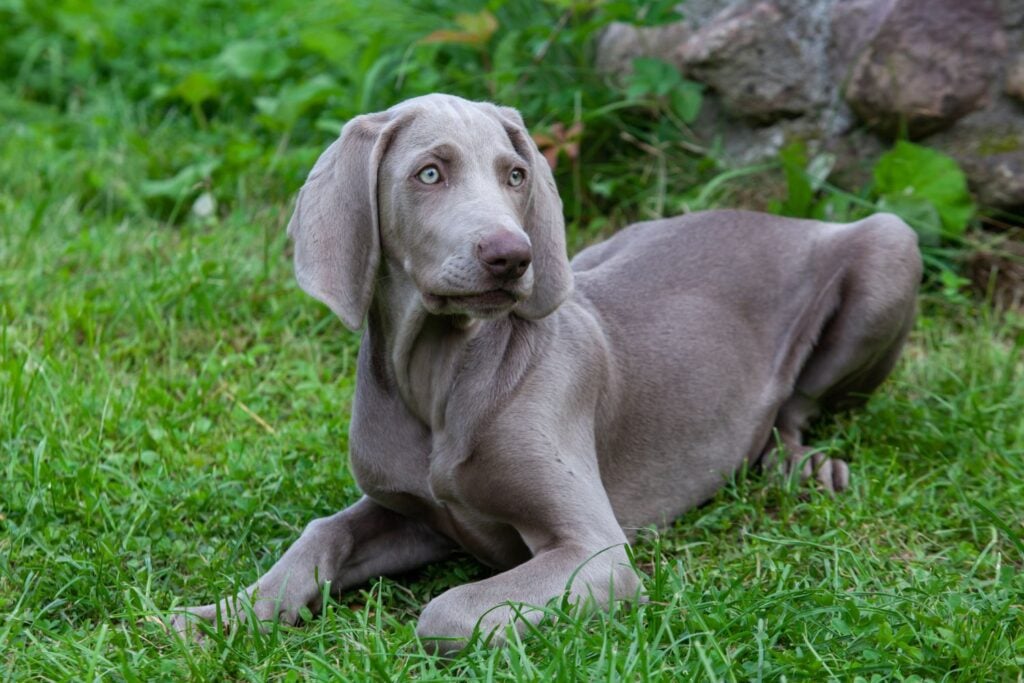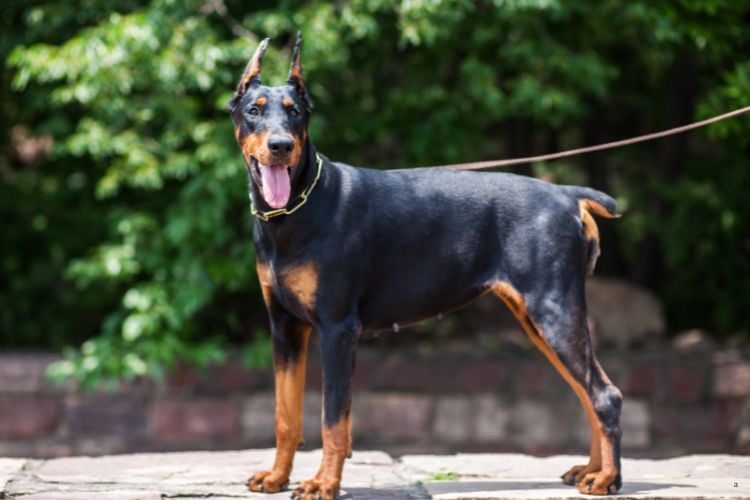Deep chested giants face a silent internal threat.

Bloat, also known as gastric dilatation volvulus (GDV), is one of the most life threatening emergencies in dogs, and it strikes quickly. The condition occurs when the stomach fills with gas and twists on itself, cutting off blood supply and trapping air inside. Certain large, deep chested breeds face a significantly higher risk, but medium dogs are not exempt. Recent veterinary research continues to refine which breeds face the greatest danger. Understanding these risks, along with prevention, can save lives, since early action often determines whether a dog survives this catastrophic event.
1. Great Danes face the highest bloat risk of all.

The Great Dane’s combination of massive frame, deep chest, and delicate stomach placement makes it the number one breed at risk for GDV. Veterinary studies estimate nearly one in three Great Danes will experience bloat during their lifetime, according to the American Kennel Club. Their size gives gas more room to build up before signs appear, and when torsion begins, it progresses at lightning speed. Early symptoms often include pacing, drooling, and unsuccessful attempts to vomit.
Veterinarians often recommend a preventive gastropexy, a surgical procedure that anchors the stomach and prevents twisting. For Great Danes, this surgery can be lifesaving.
2. Saint Bernards rank among the most vulnerable giants.

Saint Bernards are gentle, enormous dogs, but their deep barrel chests put them at high risk for GDV. Researchers note that their large, heavy bodies and tendency to eat quickly encourage gas accumulation, which can make the stomach rotate. As stated by the Cornell University College of Veterinary Medicine, their anatomy mirrors that of other giant breeds known for high bloat rates. Owners frequently mistake early distress for simple indigestion, delaying treatment until collapse.
Preventing bloat in Saint Bernards means feeding several smaller meals per day, avoiding rapid eating, and reducing stress or heavy exercise around mealtime. Consistency saves lives.
3. Weimaraners show one of the strongest genetic links.

Weimaraners are athletic, deep chested, and highly active, three features that increase the likelihood of gastric torsion. Studies have shown they possess one of the highest relative risks for GDV among large dogs. Their slender frame leaves the stomach suspended, free to rotate under pressure. As discovered by Purdue University’s GDV research project, Weimaraners combine physical and behavioral traits that predispose them to bloat. Stress or excitement can also act as a trigger.
Owners should space meals, provide calm feeding environments, and consider slow feeder bowls. Immediate veterinary care at the first sign of abdominal swelling is crucial.
4. Irish Setters often experience GDV during high activity.

Irish Setters, known for boundless energy, often eat quickly and leap into motion afterward, which creates the perfect storm for bloat. Their narrow, deep chest design makes the stomach vulnerable to rotation after a large meal. Many cases occur in otherwise healthy young adults that show no previous digestive trouble. Because Irish Setters are social and easily excitable, stress and anticipation before feeding can also trigger swallowing excess air.
Feeding in quiet spaces, discouraging vigorous play after meals, and dividing food into multiple smaller portions significantly reduce risk. Predictable feeding routines keep their stomachs stable.
5. Standard Poodles have an underrecognized predisposition.

Despite their elegance, Standard Poodles face serious danger from GDV. Their long torso and deep chest structure create internal room for stomach displacement. Veterinary data places them among the top ten breeds most likely to suffer bloat. The condition often strikes suddenly in otherwise healthy dogs. Owners may notice drooling, panting, or a distended abdomen just minutes before collapse. Delayed response dramatically reduces survival odds.
Feeding smaller meals throughout the day, discouraging rapid eating, and avoiding raised food bowls can help lower risk. A prophylactic stomach tacking surgery during spay or neuter procedures is also strongly advised.
6. Doberman Pinschers combine build and behavior that heighten risk.

Dobermans possess sleek, muscular bodies with deep, narrow chests—an ideal setup for GDV. Their alert, anxious temperament also encourages rapid eating and air gulping. Even moderate activity after meals can trigger stomach rotation. Studies on breed predisposition frequently include Dobermans in the higher risk category, with middle aged males most commonly affected. Owners often describe restlessness and unproductive retching as early symptoms, followed quickly by shock.
Reducing anxiety during feeding, encouraging calm behavior afterward, and feeding smaller portions can dramatically reduce incidents. Preventive surgery remains an option for high risk lines or anxious individuals.
7. Rottweilers show structural vulnerability that mirrors larger breeds.

Rottweilers possess broad bodies and deep, muscular chests that create pressure points where the stomach can rotate. Their hearty appetite and tendency to eat large volumes quickly increase internal gas buildup. In veterinary field studies, they rank among breeds with elevated GDV prevalence, especially in older males. Rottweilers often show subtle signs before collapse, such as discomfort, drooling, or pacing.
Preventing bloat in Rottweilers begins with portion control and slow feeding. Owners should avoid exercising their dogs within an hour of meals and watch closely for post-meal discomfort that may signal early torsion.
8. German Shepherd Dogs experience moderate but notable risk.

German Shepherds may not be giants, yet their deep rib cage and sensitive digestive systems place them within the moderate risk group. The risk increases with age and stress. In these dogs, GDV may develop gradually before rapidly worsening. Because they are so common, their overall case numbers remain high compared to many breeds. Restlessness, swelling, and unsuccessful vomiting attempts are frequent first clues.
Meal management matters most for prevention. Feeding two or three smaller meals daily, maintaining hydration, and providing calm surroundings can help protect against sudden bloat episodes in this breed.
9. Irish Wolfhounds face life threatening odds from their size.

The towering Irish Wolfhound’s enormous frame makes them vulnerable to many size-related conditions, including bloat. Their chest depth and rapid growth contribute to stomach instability. Even with ideal care, Wolfhounds have among the shortest lifespans of all dogs, and GDV shortens it further if not addressed immediately. Owners often report collapse occurring within minutes of visible bloating.
For Irish Wolfhounds, prevention includes limiting exercise near meals, keeping stress minimal, and seeking surgical tacking early in life. Routine monitoring of eating behavior and post-meal comfort becomes part of daily health management.
10. Gordon Setters share risks with other deep chested hunters.

Gordon Setters are powerful and athletic, bred for endurance. Their deep chest structure and active lifestyle make them prone to GDV. Though not as large as Danes or Wolfhounds, their body mechanics resemble those high risk breeds. Affected dogs can deteriorate rapidly without intervention, making awareness critical. Genetics, stress, and feeding habits all play measurable roles.
Owners can reduce odds through slow feeding techniques, calm post-meal environments, and routine veterinary checkups. Recognizing early abdominal swelling or changes in breathing can make the difference between recovery and tragedy.
11. Borzois rank high in predisposition among sighthounds.

The Borzoi’s slender frame and deep chest give elegance but also elevate GDV risk. Studies have shown that sighthounds as a group possess elongated torsos that allow stomach movement under pressure. Their calm demeanor hides early discomfort, delaying detection. Owners often mistake mild restlessness for fatigue until symptoms escalate.
Prevention focuses on maintaining consistent feeding schedules and avoiding large, single meals. Routine veterinary consultations can help owners assess anatomical risk and decide if preventive gastropexy would be worthwhile, particularly in breeding lines where GDV has appeared before.
12. Akitas also fall within the danger zone for bloat.

Akitas, though not towering giants, possess muscular, barrel shaped chests that make them candidates for GDV. Their risk rises with age and with behaviors like fast eating or high stress feeding environments. Once torsion begins, their dense muscle mass can mask visible bloating, delaying recognition. Emergency care must be immediate to prevent fatal shock.
Owners can lower risk by managing weight, using slow feeder bowls, and maintaining strict meal timing. For Akitas from high risk bloodlines, preventive surgery is a strong consideration. Consistent awareness gives these powerful dogs a far better survival outlook.
13. Preventing bloat across all breeds.

Avoiding bloat begins with routine rather than reaction. Feed two or three smaller meals daily instead of one large portion. Keep water available but discourage gulping large volumes right after eating. Exercise should wait at least an hour after meals. Using slow feeder bowls and avoiding raised dishes can also help. For breeds with documented high risk, veterinarians often recommend a prophylactic gastropexy performed during spay or neuter surgery.
Recognizing early signs—distended abdomen, drooling, pacing, and attempts to vomit without success—allows quick intervention. For every dog, prevention and immediate response are the surest paths to survival.
